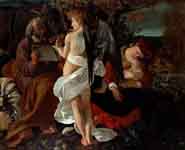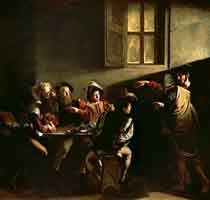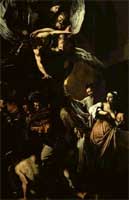Michelangelo Merisi, known as Caravaggio, was born in Milan in 1571. He trained with the painter Simone Peterzano in Milan, where he became acquainted with two different art traditions: Lombardy realism and Veneto Renaissance. He saw the latter when Peterzano took him with him on a journey to Venice, where he became acquainted with Tintoretto’s art.
He moved to Rome at the age of twenty, working first with Lorenzo Siciliano, then Antiveduto Gramatica and then Cavalier d'Arpino.
The latter employed him for ‘general paintings’, with fruit or plants as subject. This type of picture was snubbed by academicians because it was regarded as ‘l ess noble’ than paintings with people. Caravaggio invented his own repertoire of subjects, portraying ordinary boys, posing with baskets of fruit, goblets and glass objects. One of this artist’s first paintings was Sick Bacchus, now in the Borghese Gallery of Rome, painted in about 1591. It is considered a self-portrait, painted while he was in hospital and sick with malaria. Other early works are: Boy bitten by a lizard, Young man with a basket of fruit and Bacchus, in the Uffizi Gallery. Caravaggio’s love for musical subjects and ordinary life is visible in paintings like the Cheats, the Good News, the Lute player. A splendid example is the Fruit basket, now in the Ambrosian Gallery of Milan, where all subjects are highly realistic: a dry leaf, a bad apple. There is no attempt to change or improve the objects.
ess noble’ than paintings with people. Caravaggio invented his own repertoire of subjects, portraying ordinary boys, posing with baskets of fruit, goblets and glass objects. One of this artist’s first paintings was Sick Bacchus, now in the Borghese Gallery of Rome, painted in about 1591. It is considered a self-portrait, painted while he was in hospital and sick with malaria. Other early works are: Boy bitten by a lizard, Young man with a basket of fruit and Bacchus, in the Uffizi Gallery. Caravaggio’s love for musical subjects and ordinary life is visible in paintings like the Cheats, the Good News, the Lute player. A splendid example is the Fruit basket, now in the Ambrosian Gallery of Milan, where all subjects are highly realistic: a dry leaf, a bad apple. There is no attempt to change or improve the objects.
In about 1595 he painted the first figures in the Rest during the flight into Egypt. The influence of great painters from Bergamo and Brescia (such as Savoldo, Lorenzo Lotto and Moretto) is clear. The influence of Roman culture is also clear in the angel turning its back to the viewer, the pivot of the whole painting. The artist left Cavalier d'Arpino in this period and worked for the Cardinal Francesco Maria Del Monte. Thanks to his new patron he entered a world which was far more stimulating culturally, which lead him to paint The head of Medusa, St John the Baptist, Winning Love, Judith and Olophernes.
The birth of a personal style is  visible in the paintings of the Contarelli chapel in St Luigi dei Francesi, in Rome. He painted three pictures: the Calling of St Matthew, the Martyrdom of St Matthew and St Matthew and the angel. The Martyrdom of St Matthew is the beginning of Caravaggio’s light and dark style which will develop in later works. In the Calling of St Matthew the story is set in the present, with figures wearing XVI century clothes. The central element of the whole painting is light: a soft light enters from a window (not visible in the picture) on the left and falls on the arm of Christ emerging from the shadows on the right. This effect leads the observer’s eye from the right to the left, from the group of figures to the movement of Christ.
visible in the paintings of the Contarelli chapel in St Luigi dei Francesi, in Rome. He painted three pictures: the Calling of St Matthew, the Martyrdom of St Matthew and St Matthew and the angel. The Martyrdom of St Matthew is the beginning of Caravaggio’s light and dark style which will develop in later works. In the Calling of St Matthew the story is set in the present, with figures wearing XVI century clothes. The central element of the whole painting is light: a soft light enters from a window (not visible in the picture) on the left and falls on the arm of Christ emerging from the shadows on the right. This effect leads the observer’s eye from the right to the left, from the group of figures to the movement of Christ.
There were two versions of St Matthew and the angel but the first was refused because St Matthew looked too vulgar and seemed to be behaving in an inappropriate way, which was highly unacceptable at the time. Nothing is known about what happened to this painting. Before this Caravaggio was commissioned two paintings for the Cerasi chapel of Santa Maria del Popolo: Crucifixion of St Peter and the Conversion of St Paul. The painter interpreted two holy events as two purely human events and ignored all the conventions used until then.
He then painted the Deposition for the church of Santa Maria in Vallicella (now in the Vatican Picture Gallery). The pyramid structureof the work is reminiscent of Michelangelo’s compositions.
In this period the artist painted the Madonna of the Pilgrims and the Madonna dei Palafrenieri and the  Death of the Virgin for Santa Maria of the Scala in Trastevere. This painting was refused on the grounds of decorum and is now in the Louvre.
Death of the Virgin for Santa Maria of the Scala in Trastevere. This painting was refused on the grounds of decorum and is now in the Louvre.
Between 1606 and 1607 Caravaggio lived in Naples, where some important paintings can be admired: the canvas with the Seven deeds of Pity, in the Pio Monte della Misericordia, and the Flagellation of Christ, in the Capodimonte Museum.
In 1608 the painter was in Malta where he was knighted – a pardon for his previous unruly life. He had had to flee from Rome because he had killed a man in a fight. His biggest canvas was painted here: the Beheading of the Baptist, with few objects, dull colours and a sordid setting.
He was expelled from the Order of Malta and fled to Syracuse, where he painted the Burial of St Lucy. This painting, like others painted in Messina (resurrection of Lazarus and the Shepherds’ Adoration), are characterised by considerable empty space on large canvases.
In 1609 he was in Naples again where he was seriously wounded. Works from this period are David with the head of Goliath and Salomé with the head of the Baptist.
In 1610, on the beach of Porto Ercole, as he was waiting to return to Rome for his pardon, he was arrested and imprisoned for two days. It was probably a case of mistaken identity but it cost Caravaggio all his belongings. He died two days later of the “evil fever” while he was looking for his belongings, according to Bellori. It was 18th july 1610 and Caravaggio was not 39; the pardon and the permission to return to Rome were granted a few days later.